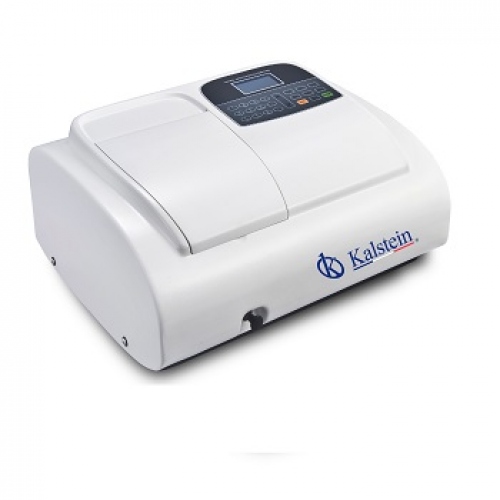When it comes to spectrophotometry, selecting the right equipment can significantly impact the precision and efficiency of your laboratory processes. Today, we dive into a detailed comparison of two outstanding spectrophotometers: the UV / VIS Spectrophotometer – YR01853 from Kalstein and the UV-1800 UV-VIS Spectrophotometer from Shimadzu. Both devices stand out for their advanced capabilities, but subtle differences could sway your decision, depending on your specific laboratory needs.
The UV / VIS Spectrophotometer – YR01853 by Kalstein offers unparalleled precision with a wavelength range of 190-1100 nm, ensuring it meets the most demanding analytical requirements. Known for its user-friendly interface, this spectrophotometer integrates sophisticated software that simplifies data management. Built with durability in mind, the YR01853 ensures consistent performance over time, making it a valuable investment for labs prioritizing reliability and accuracy. Conversely, the Shimadzu UV-1800 boasts compact design and high resolution, with a wavelength range of 190-1100 nm as well. It promises robust performance, although users may find its interface slightly more challenging compared to Kalstein’s user-centric design.
| Feature | Kalstein YR01853 | Shimadzu UV-1800 |
|---|---|---|
| Wavelength Range | 190-1100 nm | 190-1100 nm |
| User Interface | Intuitive, User-friendly | Complex, Less Intuitive |
| Data Management | Integrated, Software-Driven | Standard |
| Design | Durable & Robust | Compact |
| Market Price | Competitive | Mid to High Range |
How They Work
The Kalstein YR01853 spectrophotometer utilizes a sophisticated optical system to measure the intensity of light absorbed by a sample at various wavelengths. The sample is placed in a cuvette and exposed to monochromatic light. The device then measures the absorbance, which relates to the concentration of substances within the sample. Similarly, the Shimadzu UV-1800 operates on the same principle, utilizing a double-beam system to ensure accurate measurements by comparing the sample beam to a reference beam.
What They Are Used For
Both spectrophotometers are pivotal in laboratories for qualitative and quantitative analysis of samples. They are extensively used in biochemical research, pharmaceutical applications, and environmental testing, where precise measurement of light absorption helps determine the concentration of solutes in a solution. The Kalstein YR01853, with its enhanced software capabilities, extends its usability to more complex data analysis tasks, making it highly versatile for advanced research environments.
Types
While focusing on absorption, UV-VIS spectrophotometers come in various types, such as single-beam and double-beam configurations. The Kalstein YR01853 is a single-beam system, ideal for straightforward, reliable assessments, while the Shimadzu UV-1800 utilizes a double-beam system, allowing for simultaneous reference measurements that may enhance precision slightly in specific setups.
Market Price
Spectrophotometers typically range in price based on features and brand reputation. The Kalstein YR01853 is competitively priced, offering advanced features without a sky-high cost, making it accessible to a wider range of laboratories. The Shimadzu UV-1800, while also highly reputable, tends to fall within a mid-to-high price bracket due to its compact design and brand prestige.
Frequently Asked Questions
What is the main advantage of the Kalstein YR01853 over the Shimadzu UV-1800?
The Kalstein YR01853 offers a more intuitive user interface and enhanced data management features, which can save time and reduce error in data analysis.
Are there differences in wavelength range between the two products?
No, both the Kalstein YR01853 and the Shimadzu UV-1800 offer a wavelength range of 190-1100 nm.
Which product is more user-friendly?
The Kalstein YR01853 has a more user-friendly interface, making it easier for users of all skill levels to operate effectively.
Advantages and Disadvantages
The Kalstein YR01853 spectrophotometer shines with its user-centric design, intuitive software, and competitive pricing. Its major advantages are the ease of use and comprehensive data management capabilities that cater to both novice and experienced users. On the downside, it is a single-beam system, which might slightly limit extremely precise comparative analysis. The Shimadzu UV-1800, while offering precision and a reputable brand backing, presents a steep learning curve due to its less intuitive interface and higher price point.
Product Use in the Field
In practical scenarios, the Kalstein YR01853 excels in settings where robust and consistent results are essential, such as in quality control laboratories and university research departments. Its reliability ensures that even under the most rigorous testing conditions, the results remain accurate. The Shimadzu UV-1800, with its compact design, fits well in labs where space is of the essence and high-resolution readings are regularly required.
Recommendations
To maximize the use of the Kalstein YR01853 spectrophotometer, regular maintenance, such as cleaning cuvettes properly and calibrating the instrument as recommended by the manufacturer, ensures long-term accuracy and performance. For labs upgrading equipment, consider the comprehensive features of the YR01853, which offer excellent return on investment due to reduced error rates and improved user efficiency.
If you are looking for a fusion of innovation and quality, you have reached the right place. At Kalstein, we offer you the luxury of exploring our exclusive catalog of laboratory equipment. We manufacture each piece of equipment with a level of excellence. Our intuitive and agile online purchase channels are designed for your convenience, ensuring the most friendly prices. Don’t hesitate anymore; we bring science to life, and it is time for you to be part of our community. https://kalstein.us/product/uv-vis-spectrophotometer-yr01853/.

